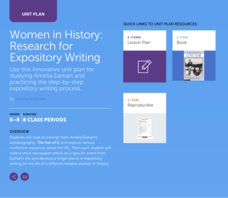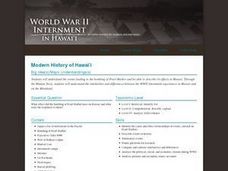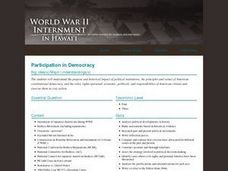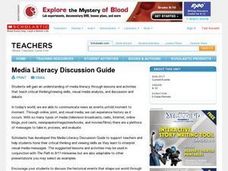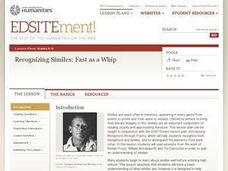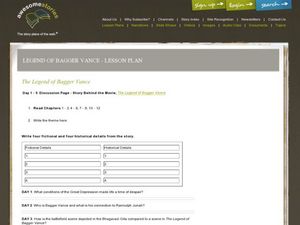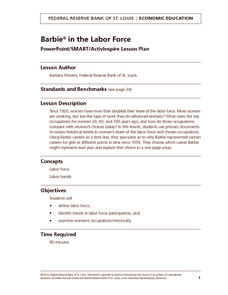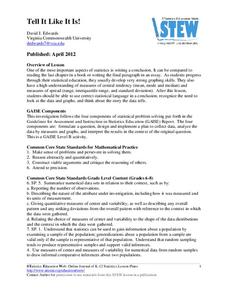Curated OER
Cinderella Folk Tales: Variations in Plot and Setting
Young scholars examine plot and setting of Cinderella, and how it changes as it is translated into different cultures, discuss universal literary elements of the Cinderella story, and write narratives with original settings and plots...
Curated OER
Conflict Resolution
A thought-provoking language arts worksheet prompts learners to respond to seven questions that deal with sociology. Additionally, they consider topics regarding animal rights. Sure to spark some engaging conversations in your class!
Curated OER
The Red Scare
Students identify and interpret issues of Nativism and Protectionism in early 20th Century America. They analyze the roots of anti-immigrant movements in the Post-World War One United States. Finally, students identify and explore the...
Curated OER
League of Nations
What is the League of Nations, when did it begin, and what is it's purpose? Young political minds can explore the answers to these questions through political cartoon analysis. Included are several political cartoons, an analysis...
Curated OER
Metric Conversion
Fifth graders access prior knowledge to complete a do now using metric conversion. In this metric conversion instructional activity, 5th graders will respond to problems and analyze for a possible mnemonic device.
Curated OER
Women in History: Research for Expository Writing
After reading an excerpt from Amelia Earhart's autobiography, The Fun of It, learners explore various nonfiction resources about her life and write a short newspaper article on a specific event. They then develop a longer piece of...
Curated OER
World War II: Modern History of Hawaii
Students examine world geography by viewing a documentary film in class. In this World War II lesson, students discuss the role Hawaii played in the great battle and what type conflicts happened among the island chain. Students view a...
Curated OER
Participating in Democracy
Students analyze film clips in class. In this democracy lesson plan, students identify the differences between civil liberties, democracy and freedom. Students view a video regarding Japanese internment and answer study questions as well...
National Endowment for the Humanities
A Raisin in the Sun: Whose "American Dream"?
How does Lorraine Hansberry's A Raisin in the Sun factor into a discussion of the American dream? High schoolers define the American dream and recognize the historical setting of the play. Additionally, they identify...
Curated OER
Media Literacy Discussion Guide
Students examine and analyze visual media and its messages critically. They determine whether specific media messages inform, entertain, or persuade and what factors influence the media. Using primary sources, they participate in peer...
Curated OER
Recognizing Similies: Fast as a Whip
High schoolers review what they have already learned about similies and begin to engage with similies on a deeper and more abstract level as they create their own.
Curated OER
Recognizing Similes: Fast as a Whip
Students review basic knowledge of similes and engage with similes on a more abstract level. In this similes lesson, students define similes and identify examples. Students read and analyze the similes used in poetry by Derricotte,...
Curated OER
Figurative Language - Part Two
Learners need to use their papers from Part One of this lesson. They then write a paragraph for each term. This exercise help them to use these terms in their writing. Using figurative language makes writing more descriptive and alive.
Curated OER
Humane Science Projects
In this science worksheet, middle schoolers examine the list of possible science projects. They look for the characteristics that set apart these ideas as humane.
Curated OER
The Legend of Bagger Vance
In this The Legend of Bagger Vance worksheet, students read the book The Legend of Bagger Vance and complete activities including historical and fictional details, short answer questions, and character details. Students complete 21...
Curated OER
Writing a Fable
Students are introduced to the definition of a fable in that it is a story that has a moral for people to apply in their lives. They then read a fable together so they have a better understanding. Next, students write their own fables.
Curated OER
Breaking Barriers with Melba Pattillo
Students are introduced to individuals who made the civil rights movement a success. They examine, analyze and interpret the events and people who had a significant and stirring impact on the course of history through stories, interviews...
Foreign Policy Research Institute
Ancient History: The Importance of Logistics in Greek & Roman Armies
Before one can understand the military tactics practiced throughout history, he needs to become familiarized with tactics practiced in the ancient past. Learners take a critical look at the military logistics used by Alexander the Great...
PBS
Historical Perspectives: Coming Home from War
What do the homecoming experiences of soldiers who fought in WWII, Vietnam, Iraq, and Afghanistan reveal about the politics and culture of the US during the time period of each war? Young historians view The Way We Get By, which tells...
Curated OER
Recurring Nightmares
Does history really repeat itself? Encourage your middle and high schoolers to answer this age-old question by reading the attached articles on the Cuban Missile Crisis of 1962 and the Iraq Crisis of 2002. How similar or different are...
Curated OER
Excel, Word, and Basketball
Wow, this lesson packs a punch. Pupils interview basketball players, write about a game, and use Excel to organize statistics related to the players and the points scored. Afterward, they create posters, presentations, and much more.
Federal Reserve Bank
Barbie in the Labor Force
How have the women's share of the labor force and chosen occupations evolved in the United States over the last century? Using census reports, graphs detailing the gender makeup of the labor force, and analysis of the careers of...
American Statistical Association
Tell it Like it is!
Scholars apply prior knowledge of statistics to write a conclusion. They summarize using correct academic language and tell the story of the data.
Curated OER
That's Moor Like It!
How do modern adaptations of Shakespearean plays relate to their original source material? Middle and high schoolers focus on Shakespeare's play Othello and its screen adaptation "O" to explore how modern film adaptations of Shakespeare...







